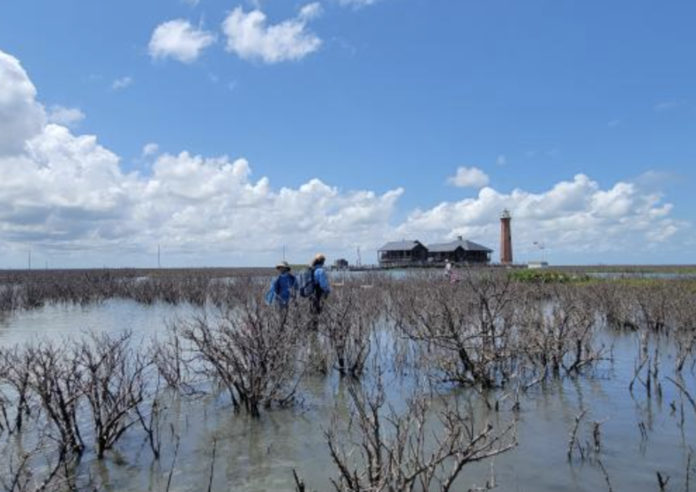To better understand important dynamics at play in flood-prone coastal areas, Oak Ridge National Laboratory scientists working on simulations of Earth’s carbon and nutrient cycles paid a visit to experimentalists gathering data in a Texas wetland. There, the return of a key mangrove species holds important clues to current and future climate impacts in coastal ecosystems.
ORNL’s Ben Sulman and Shannon Jones traveled this summer to Port Aransas, Texas, where black mangroves are experiencing a rebirth after being devastated by an extreme freeze in 2021. Mangroves, which thrive in salty, brackish water, defend coastal ecosystems from storm surge and provide important habitat for fish, reptiles and birds. They support the fishing industry, remove carbon from the atmosphere and could expand along U.S. Gulf coasts as the climate warms.
Mangroves and other coastal processes affecting the carbon and nitrogen cycles are underrepresented in current Earth-scale land system models. By observing the collection of data along the Texas coast, Sulman and Jones gained a better understanding of the conditions and dynamics needed to improve large-scale Earth simulations that can better predict and help prepare coastal communities for flooding and other climate-related risks.
Jones is a postdoctoral researcher with a background in hydrology and flood modeling. She is working with Sulman on representing biogeochemical processes in coastal wetland models to better predict ecosystem responses to climate change, human activity and sea level rise. The work is part of a Department of Energy Early Career Research Program award led by Sulman. Jones’ goal is to assess changes in carbon and nitrogen cycling in these ecosystems in DOE’s Exascale Earth System, or E3SM, land model, known as ELM, with a focus on the effects of mangrove expansion into salt marsh areas.
The ORNL scientists joined field excursion leads from the University of Texas, Austin and collaborators from the U.S. Geological Survey and the University of Louisiana, Lafayette. In this firsthand account, Jones describes the field work experience and how it is informing her current research.
Sailing towards mangrove ecosystem recovery
I reached out to UT-Austin scientists to discuss the main characteristics of mangrove nutrient cycling that differentiate them from other wetland plant species. A university team led by Ashley Matheny had been collecting data at a coastal Texas mangrove site that is providing unique insights into how the ecosystem is recovering after a deep freeze event in 2021. This piqued my interest and Ben’s as we are focused on defining, or parameterizing, the limits of survival for plants in the model to more accurately simulate wetland plants that live in highly dynamic areas. We decided to join a field excursion organized and led by Matheny.
We got an early start on the day of the field sampling trip, leaving from the University of Texas’s Marine Science Institute, or UT MSI, at Port Aransas. The mangrove site, only accessible by boat, is located on an island in Aransas Bay between the mainland and the barrier island. At 7 a.m., we met with Ashley Matheny, Melinda Martinez of the U.S. Geological Survey and two graduate students, Robert Bordelon and Aaron Gondran from UL, Lafayette, for a quick safety briefing, to discuss the field plan, and load the equipment into the boat. The eight-seater boat is owned and operated by UT MSI and was driven by a licensed UT MSI boat captain.
The waves were calm as the boat took off from the dock. A mist of salt and waves filled the air as the boat headed towards the island. The boat ride took approximately 20 minutes through a shipping channel to Harbor Island near a historic lighthouse.






